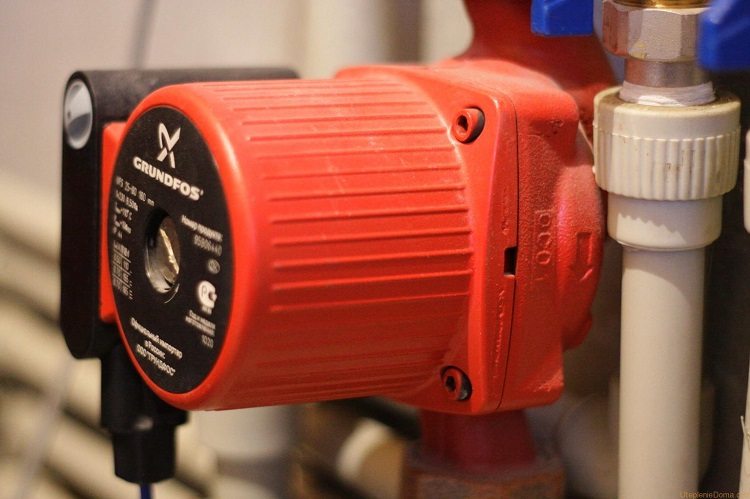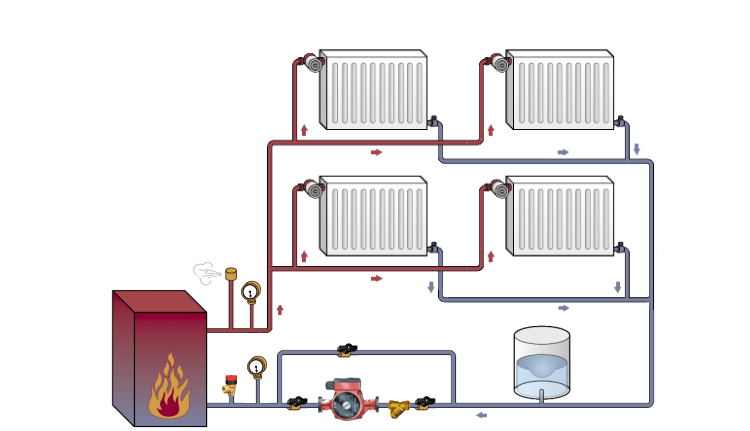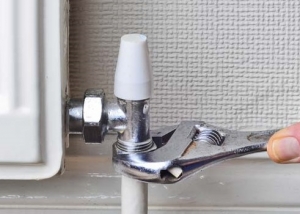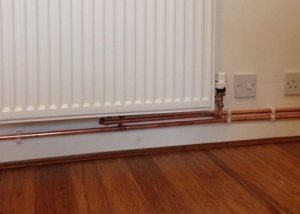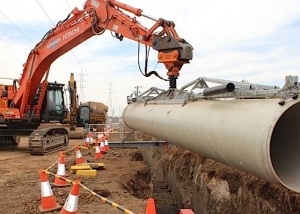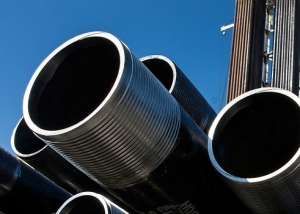Conduct heating in a private house in various ways. It is necessary to decide on the most profitable and most suitable variant of such a system even at the stage of creating the project of the entire structure. To do this, compare the scope of the existing budget and the satisfaction of their own needs. Of course, knowledge of the main similarities and differences between single-pipe and two-pipe heating systems will also not hurt.
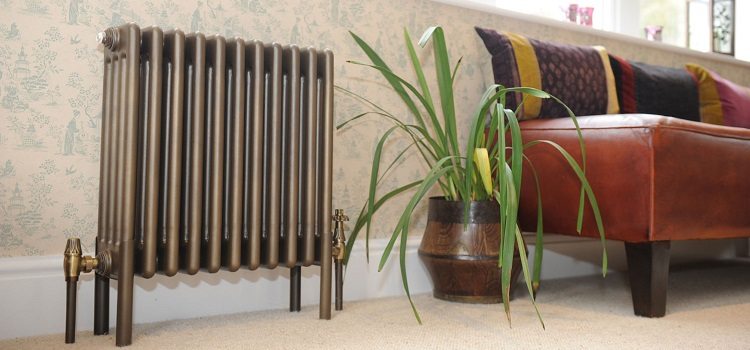
The heating system is the most important factor for the comfort of a home, so you need to be very serious about choosing such a system
Content
What do the two systems have in common
Any of the above heating systems includes the following main components:
- boiler;
- thermostatic valve;
- safety valve;
- radiators;
- membrane expansion tank;
- valve (ball valve);
- circulation pump. This unit controls the forced circulation of the coolant in both single-pipe and two-pipe heating systems.
There are also general points about mounting.
Location of the boiler. This factor is a very important parameter when choosing the most suitable heating scheme for a private house. Acting as the main heating equipment, this unit should be installed below the location of the horizontal center of the batteries or cooling points. Such a solution will provide a one- or two-pipe heating system with natural or forced circulation with the correct gravitational pressure.
Having decided on the location of the boiler, regardless of the type of piping, they usually start marking the points where the remaining elements of the heating system will be installed:
- necessary radiators;
- risers;
- pipes for water supply.
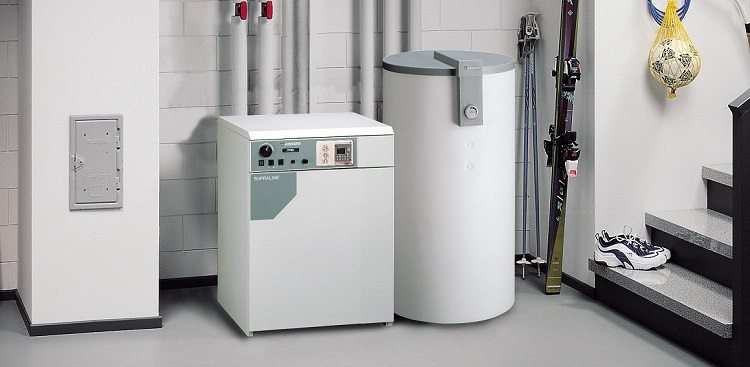
Regardless of the selected heating scheme, the boiler must be positioned below the battery level, therefore more often a basement is allocated for the boiler room
Installation of radiators. Installation is carried out directly under the window openings. Regardless of whether the one-pipe or two-pipe heating system is selected, from the point of view of the laws of physics, this installation of batteries heats not only the room, but also the internal window frame, as well as the glass surface.
Good to know! Among other things, the effect of “crying” windows due to the shift of the dew point will be eliminated.
In order for the heat transfer to be optimal, the following conditions must be observed:
- the distance of the radiator from the wall should be no more than 5 centimeters;
- distance from the floor to the bottom of the battery - 10 centimeters;
- between the windowsill and the top point of the radiator, the correct distance is the same 10 centimeters.
Regardless of which one-pipe or two-pipe heating system is selected, during installation, too many not only bends, but also straight long sections of pipes should be avoided. This applies to any pipes - steel, copper and plastic. The combination of these factors leads to a slow circulation of water, which leads to a decrease in the efficiency of the entire created heating structure.
The principle of operation of a single pipe line. Advantages and disadvantages
How a single-tube strapping functions is extremely understandable.The coolant is supplied through one closed system, including a heating installation and heating devices. They are tied together with only one contour.

For a one-pipe system, only one circuit is mounted and it is better to install such a system in a one-story building
The riser in such a system is also one. It is he who connects in a certain sequence all the technical nodes. In apartment buildings, a hydraulic pump is often used to provide heat transfer. He pumps hot water along vertical risers.
There are two schemes for implementing a single pipe system:
- horizontal. For a private home, it is best suited. According to this scheme, all radiators are connected in series using a horizontal riser;
- vertical. It is used to create heating systems in multi-storey buildings. Battery connection in this case is carried out from the upper floors to the lower ones by means of a vertical riser.
In order to find out the answer to the question of which heating system - one-pipe or two-pipe is better, it is necessary to consider their pros and cons. The negative factors associated with tying one pipe include the following factors:
- Do not connect more than 10 batteries to a vertical riser at a time. Failure to comply with this requirement will lead to the fact that on the lower floor the radiators will not warm up above + 45 ° C (which is not enough for comfort in the winter season), while at the very top the coolant temperature can reach + 105 ° C;
- the inability to adjust the temperature in a single room. If with the help of a thermal valve somewhere in the middle to shut off the coolant supply, all the next radiators in the chain will become cold;
- the need to install a powerful pump. This equipment provides a pressure level inside the system, without which the effective operation of a single-pipe strapping is impossible. Its inclusion, of course, leads to an increase in operating costs.
Helpful information! A hydraulic pump of any type is not able to provide uniform pressure inside the system, which can cause water hammer, resulting in leaks.
Along with the minuses, the single-tube system has a number of positive operational characteristics. The most relevant are the following:
- Batteries appeared on the market, the design of which eliminates the unevenness of the heating of rooms. They are understaffed with radiator regulators, thermostatic valves or automatic temperature regulators. These products can be installed in one-pipe and two-pipe heating systems.
- the use of equipment such as bypasses and valves, as well as reliable shut-off valves, allows not to turn off the entire system when repairing one heating device;
- a single-pipe system is collected with less material than a two-pipe system. Therefore, it is recommended to choose it with a limited budget.
The principle of operation of the two-pipe system. Advantages and disadvantages
This scheme involves raising the coolant up the riser with its subsequent connection to each heating device. And then, along the return branch, it is transported to the boiler. That is, each battery is served by two pipes. Hence the name of such a system - two-pipe.
Of its advantages, it is worth highlighting:
- the ability to organize uniform heating of each radiator. Regardless of the floor, the coolant is supplied with the same temperature to each battery. The installation of the thermostat allows you to set such a temperature mode of heating, which is best suited to current weather conditions;
- no need to use a powerful pump.In a two-pipe strapping, significant pressure losses are absent. Water is able to circulate by gravity due to the force of gravity. With a low pressure, a cheaper low-power pumping unit can be dispensed with;
- to repair one individual heating device is allowed without shutting down the entire heating system.
An additional bonus of the two-pipe strapping is the ability to use both associated and dead-end movement of hot water.
In a concurrent scheme, the water in the supply and return flows in one direction. The coolant circulation in the dead end circuit occurs in opposite directions. In the first case, if radiators of the same power are used, ideal hydraulic balancing is formed. Thus, there is no need for battery preset valves.
If heating appliances are characterized by different power, the contractor will be forced to calculate the level of heat loss of each, perform calculations and link radiators using thermostatic valves. Without proper knowledge, it is very difficult to do it yourself.
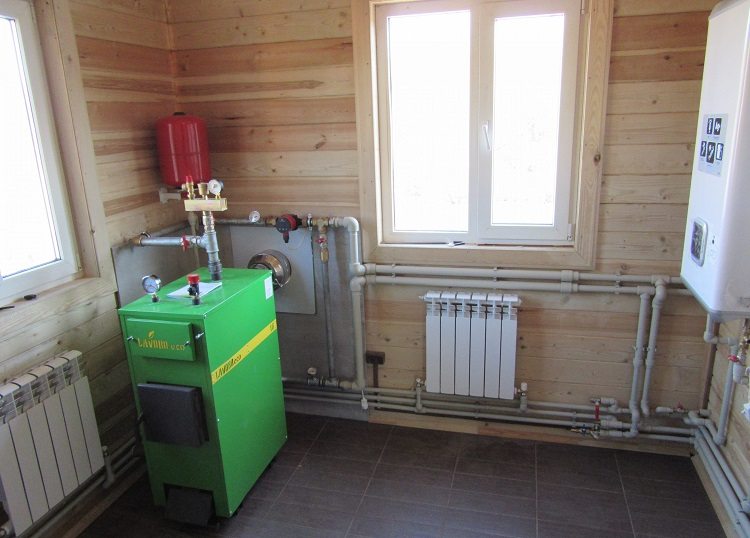
For a two-pipe system, much more pipes and components are needed, therefore, the implementation of such a scheme is more costly than a single-pipe system
Helpful information! Associated hydraulic gravity flow is best used when installing long-distance pipelines. The use of a deadlock scheme is more justified for short systems.
The disadvantages of the two-pipe system are mainly economic in nature. As mentioned above, its assembly will require 2 times more pipes. And do not forget about the need to connect them. That is, the scope of delivery should include a large number of fittings, valves, and fasteners. And even more increases the cost of installing a two-pipe system.
In the very recent past, when a two-pipe strapping was created on the basis of steel pipes using welding, the final amount was learned beyond the limits. But the advent of metal-plastic and the development of hot soldering technology led to the fact that the laying of a two-pipe heating main became accessible to the wallet of our average compatriot.
What you need to consider when arranging any system
So, you already know which system best suits your operating conditions. Before proceeding with its installation, listen to the advice of professionals. The main ones can be formulated as follows:
- Do not forget about the need to install control valves at the inlet and outlet of the batteries, as well as a drain valve, the location of which is the lowest point of the heating structure. Two-pipe wiring can be implemented in a private house of any number of storeys. It can work without a circulation pump. But due to the low efficiency of these systems, few currently use them.
- Having decided on the placement in the structure of a two-pipe wiring equipped with a collector, carefully consider and plan the placement of the so-called comb, which acts as a coolant distribution unit. The length of the pipes extending from it should be commensurate. Otherwise, a significant difference in their length from the comb to the batteries can cause a significant difference in pressure.
- Acquired, as they say, “cheaply” used pipes and fittings can result in significant monetary costs for repairing not only the heating system, but also the building itself.
Single pipe design is cheaper. But if you focus on the quality of the heating system, you should not spare money for a two-pipe wiring. So you get the opportunity to control the heat in the rooms.
